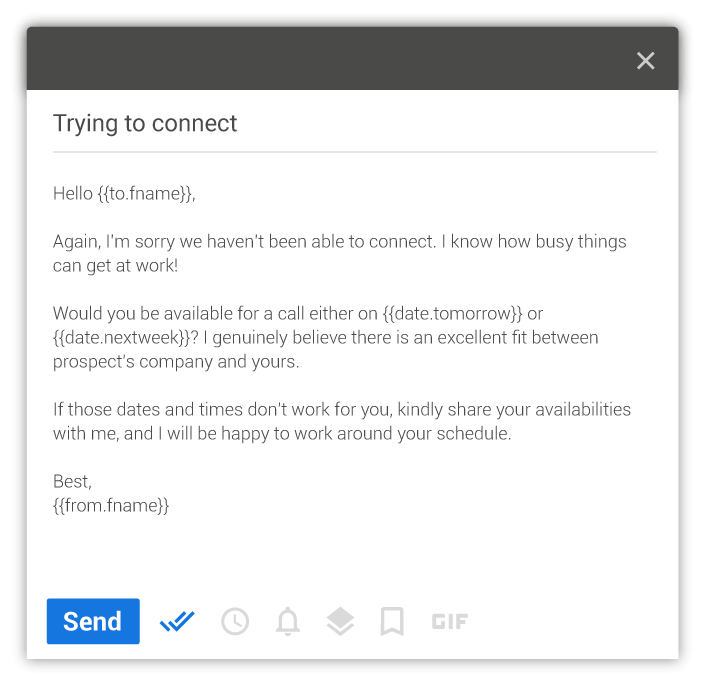On the surface, sales email follow ups are simple. Typically, they go something like this:
"Hi < Name >, I just wanted to follow up on the proposal I sent / our last phone call / our last meeting / the email I sent... "
If this is what you do, you might be losing sales. Lets see why. Follow up emails are a crucial part of the sales process. However, if you received an email like this in the middle of your busy day, would you even open it let alone act on it?
Depends! Why? It is all about context, motivation, and timing. If the person sending you the email gets those things right, you might open it. If they don't, you'll ignore it. The email above might get the timing right, but there is little context and no motivation.
So, understanding why sales email follow ups work, and how to make yours more effective, will help you get more customers.
Why do follow up sales emails work?
Here's the speed-read version:
- Decisions are rarely made at first pitch
- Increases the chance you will be in the right place at the right time
Sales email follow ups work for the same reason that other methods of following up work - because customers rarely make a decision after the first email or during the first phone call or meeting. This can be because you have to send them more information, such as a proposal. It can also be because they need time to consider their options.
Sales emails are particularly effective, however, because of timing. When a recipient ignores or doesn't act on an email you send, it doesn't mean they don't want your product or service. Often it is simply because the timing is not right - they are doing something else at the time or have different priorities. Sales email follow-ups that get the timing right get positive results.
Before You Start
Here's the speed-read version:
- Have a clearly defined objective
- Limit that objective to one action
So, you have to follow up to get sales, and email is an effective way of doing this. Don't rush into writing follow up emails, however, before defining an objective. Ask yourself what do you want to achieve by sending the email? Four common objectives with sales follow-up emails are:
- To find out if you got the sale/deal/order or not
- To request a meeting or phone call
- To start a free trial period
- To establish if the person is interested in finding out more about your product or service
It is often tempting to hedge your bets by going for multiple objectives. However, your follow up email will work better if you have just one objective as offering choices usually lowers conversion rates.
Remember also that the act of following up is not an objective itself. Following up is what you are doing, but the act of sending an email will accomplish nothing tangible for your business. The interaction of the potential customer is what counts - make your objective that interaction.
When to Send and How Often
Here's the speed-read version:
- It typically takes five follow ups to get a sale
- Send about four follow ups to a cold contact but you can potentially continue to follow up with warm leads until you get an answer
- Test how soon you should follow up to get the best results
- When appropriate, follow-up as soon as the recipient opens the email (use email tracking tools to help you do this)
It takes an average of five follow-ups with a customer before you can expect to complete a deal. That tells you a couple of things:
- Reinforces that you have to follow up
- That you shouldn't get discouraged if the client doesn't respond to the first few emails
This is exactly what many people do, however. In fact, 44 percent give up after the first contact. If you are more persistent you will pick up the sales that those people are leaving behind.
Make sure you don't forget to follow up by scheduling reminders or creating to-do lists. Doing this within your email application, like you can with Gmelius, will save you time and reduce the risk of forgetting.
How often should you send a follow-up email without getting a response before stopping, though? Usually, send no more than three or four if you are following up a cold email. If you are following up with someone who you have been in contact with before and who showed some interest in what you offer, you can usually continue following up until you get an answer.
Of course, you shouldn't ask the same question repeatedly. Instead, you should vary what your emails say, while trying to offer value, i.e. even if the recipient is not interested in what you have to offer now, give them a reason to open your email anyway.
Remember, the secret to success with follow up emails is timing. If you stop sending someone emails who once showed interest in your product or service, you will probably not be on their mind when they are ready to buy.
When should you send a sales email follow up? A lot has been written about the correct length of time between communications in the sales process. Some say three days, a week, two weeks, etc. The problem is there are too many variables - type of business, nature of product, stage of the process, to name a few.
You have to find the right time for your business, but there is one aspect of this that applies in almost all situations - the best time to follow up is often immediately after a prospect interacts with your last email. You can do this by using an email tracker, such as the read receipt function in Gmelius.
That said, not everyone will open your email and sometimes using an email tracker is not suitable. For example, you probably wouldn't want to follow up with someone immediately after they have opened a proposal email as you will need to give them time to read it, understand it, and discuss it internally. Knowing they have opened the email, however, is important information, and will help you decide your follow up approach.
Subject Line Writing
Here's the speed-read version:
- Get to the point and focus on the objective
- Keep it concise and don't use spam triggers
- Personalize it as much as possible
Here are some dos and don'ts when it comes to writing the subject line of sales follow up emails.
Don'ts
- Don't say things like you are "following up", "checking in", or "touching base"
- Don't be ambiguous or deceptive
- Don't use spam words or other spam triggers such as exclamation points or words all in capital letters
Dos
- Keep the subject line concise
- Explain exactly why you are emailing - the objective you defined earlier
- Personalize it as much as possible
Here are some examples:
- "Are you free to chat this week, < Name >" - when trying to arrange a meeting or phone call
- "Any update for us?" - when you haven't had a response to previous emails
- "Let's review the proposal this afternoon." - when following up on a proposal
Email Copy
Here's the speed-read version:
- Explain why you are sending the email and remind them of the problem your product or service can solve
- Make it easy to read and use good spelling and grammar
- Give a clear call to action and make it easy for the recipient to take that action
- Offer as much value as possible - make it worthwhile for the recipient to open the email, even if they don't make a purchase there and then
Start your email by explaining exactly why you are contacting them. Remember as well the recipient will probably see the first part of the first sentence in the preview before they open the email. This makes getting to the point quickly even more important. Here are some examples:
- "When we last spoke you said to contact you around now to..."
- "I know you're busy, but did you get a chance to look at..."
- "I sent an email last week..."
Another thing you should do in your email copy is to remind them of the problem they face and show them you have the solution. You will have already done this in any previous contacts you have had with the potential customer, but you should do it again in the follow-up email.
For example, don't just say:
"Could we schedule a 10-minute phone call to discuss Gmelius’ Business plan."
This isn't effective because the truth is, the customer doesn't care about your product. What they care about are the problems they face. You should, therefore, address those problems directly.
Using this approach, a better sentence for the example above is:
"Could we schedule a 10-minute phone call so I can explain how a inbox native CRM with collaborative capabilities can ultimate generate 10 percent more leads for your business."
Here are some other tips to make follow up emails as effective as possible:
- Make it easy to read. This usually means keeping it short but it is more important that it is readable. That means short paragraphs, bullet point lists, and headings.
- Back up what you say with links to authoritative content, testimonials, white papers, case studies, etc
- Give a clear call to action. This is critically important and cannot be over-stated. You should tell the recipient exactly what you want them to do next.
- Following on from the last point, make it as easy as possible for the customer to do the call to action.
- Good spelling and grammar are crucial.
- If you are following up a cold email, don't add attachments.
Finally, offer value that has nothing directly to do with making the sale. This builds trust with the customer, and can help keep conversations going even in situations where the customer is not quite ready to buy. Here are some examples:
- Give free tips or advice, but make sure it is specific. This means taking the time to actually look at the business to identify something that could be improved.
- Include helpful information such as a link to an article or blog post, a case study, or an eBook.
- Introduce them to someone. This is especially powerful if you introduce them to a potential customer.
Add great-performing email templates to Gmail!
We have gathered here a handful of great-performing email templates from experienced salespeople that can help you get started. Get follow-up templates now.
Use Case: The lead has not yet opened your (tracked) email.

Use Case: When you try to schedule a call with a lead.

Use Case: When you need to follow up via email after you left a voicemail.

Use Case: When you need to close the file on a lead, also known as the break-up email.

Use Case: A generic template to use for follow-ups of all cases and purposes.

Add these email templates to Gmail!
Instead of copy-pasting one by one these emails, try Gmelius templates for free. Spend time closing deals and not chasing inspiration. Get Follow-Up templates now.
Finally, take time when writing your follow-up emails and run tests to find the best form of words. This will bring benefits in the long run.

